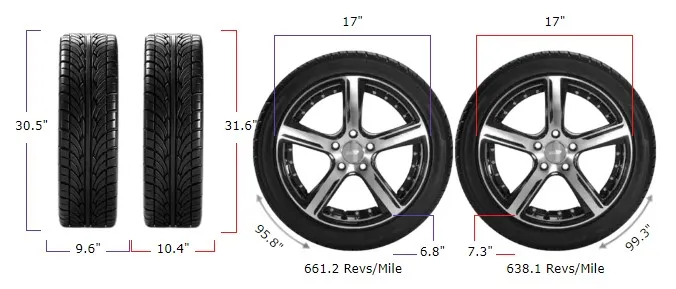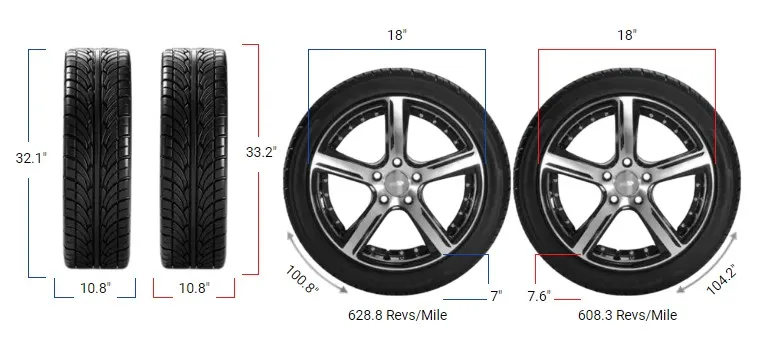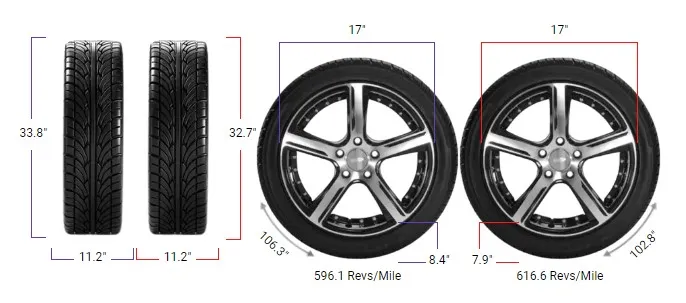Tire Size 245/70r17 vs 265/70r17

Changing from 245/70R17 to 265/70R17 tires is possible, but there are some important considerations. Let’s take a closer look at what this tire size change really means and how it may impact your driving experience, both on normal roads and off-road.
- Slightly larger tire size offers a 1.1-inch increase in overall diameter
- Wider tread provides better traction and stability, especially off-road
- Taller sidewall enhances ride comfort and durability
- Minor increase in ground clearance helps navigate uneven terrain
- Marginally slower revolutions per mile may slightly improve fuel efficiency
- Speedometer will read about 3.5% slower than actual speed

Fitment Guide
Since the 265/70R17 tires are 3.6% larger in diameter than the 245/70R17 tires, this slightly exceeds the normally recommended 3% diameter change range to ensure compatibility.
Some minor modifications, like adjusting suspension components, may be needed to prevent potential rubbing or clearance problems. However, the diameter difference is marginal enough that these tires should still fit on most vehicles designed for 245/70R17 tires.
On-Road Impact
Switching to mildly larger tires can have several effects on your on-road driving dynamics and experience. Here are some of the key areas that may be impacted:
- Ground Clearance: The 1.1″ increase in overall tire diameter effectively raises your vehicle by about 0.55″. This is equivalent to gaining an extra 14mm of ground clearance, which can be beneficial for avoiding scrapes on speed bumps, steep driveways, or uneven roads. However, the difference is minor enough that it likely won’t noticeably affect handling.
- Gas Mileage: Whenever you increase tire size, it requires more engine power to turn the larger, heavier tires, which can slightly reduce fuel efficiency. Based on the tire specs, the change from 245/70R17 to 265/70R17 will lower your revolutions per mile by about 3.5% (from 661 to 638). This means the engine will have to work a bit harder and use more gas to travel the same distance. The difference is small though, so the impact on your mileage will likely be minimal.
- Speedometer Accuracy: Because larger tires cover more ground per revolution, your speedometer (which is calibrated for the original tire size) will read about 3.5% slower than your actual speed with the 265/70R17 tires. So when your speedo says you’re going 20 mph, you’re really doing about 20.7 mph. Keep this in mind to avoid unintended speeding, but the discrepancy is minor and easy to adjust to.
- Ride Comfort: Going with a larger tire means you’ll have a bit more sidewall height (an extra 14mm). This translates to a little more cushioning between the wheels and the road, which can smooth out bumps and potholes slightly. Don’t expect a dramatic improvement though – the change is subtle.
- Aesthetics: Stepping up to 265/70R17 tires will give your vehicle a moderately more aggressive and capable look compared to the 245/70R17 size. The tires will be 0.79″ wider, with a beefier sidewall and a bit more overall height, filling out the wheel wells a tad more. This can enhance the appearance, particularly on trucks and SUVs.

Off-Road Impact
If you take your vehicle off-road, there are some added benefits and potential drawbacks to consider with the larger 265/70R17 tires compared to 245/70R17:
- Traction: The 0.79″ increase in tread width provides more rubber on the ground, improving grip on loose surfaces like dirt, sand, and gravel. Combined with the slightly taller sidewall, this can boost off-road traction a bit. However, the overall diameter change is fairly small, so don’t expect a dramatic difference.
- Durability: With the wider and marginally taller sidewalls, the 265/70R17 tires have more rubber protecting them, which can help resist dings and punctures a bit better when navigating rough terrain. The improvement is minor though – the main durability upgrade comes from choosing a tire with a stronger internal structure and tougher rubber compound.
- Wear: The larger 265/70R17 tires have a longer circumference by about 3.5%, which means they will rotate about 3.5% fewer times to travel the same distance as the 245/70R17 tires. Fewer rotations generally translates to slower tread wear, but again, the real-world difference in longevity will be quite small. Factors like tire compound, driving habits, and road conditions matter far more for tire lifespan.

What is the Difference Between 245/70R17 and 265/70R17?
The main differences between 245/70R17 and 265/70R17 tires are in the width. The 265/70R17 tire is 0.79 inches (20 mm) wider compared to the 245/70R17 tire.
Can I Use 265/70R17 Instead of 245/70R17?
While it is generally not recommended to use tires with a diameter difference exceeding 3%, the 265/70R17 tire is only 3.6% larger in diameter than the 245/70R17 tire.
This means that using a 265/70R17 tire instead of a 245/70R17 might be possible, but it could require minor adjustments to ensure proper clearance and to avoid potential rubbing issues.
How Much Wider is a 265/70R17 Tire Than a 245/70R17?
A 265/70R17 tire is 0.79 inches (20 mm) wider than a 245/70R17 tire. The width of a 245/70R17 tire is 9.65 inches (245 mm), whereas the width of a 265/70R17 tire is 10.43 inches (265 mm).
How Much Taller Is a 265/70R17 Tire Than a 245/70R17?
A 265/70R17 tire is 1.1 inches (28 mm) taller in overall diameter compared to a 245/70R17 tire. The diameter of a 245/70R17 tire is 30.5 inches (774.8 mm), while the diameter of a 265/70R17 tire is 31.61 inches (802.8 mm).
245/70r17 vs 265/70r17 Table
This table clearly outlines the differences between the two tire sizes, providing an easy-to-read comparison of their key specifications.
| Feature | 245/70R17 | 265/70R17 | Difference |
|---|---|---|---|
| Diameter inches (mm) | 30.5 (774.8) | 31.61 (802.8) | 1.1 (28) +3.6% |
| Width inches (mm) | 9.65 (245) | 10.43 (265) | 0.79 (20) +8.2% |
| Circumference inches (mm) | 95.83 (2434.11) | 99.29 (2522.07) | 3.46 (87.96) +3.6% |
| Sidewall Height inches (mm) | 6.75 (171.5) | 7.3 (185.5) | 0.55 (14) +8.2% |
| Revolutions per mile (km) | 661.16 (410.83) | 638.1 (396.5) | -23.06 (-14.33) -3.5% |
| Speedo Reading | 20 mph | 20.72 mph | +0.72 mph |
Our Observation
After analyzing the specs, we believe going from 245/70R17 to 265/70R17 tires provides some light capability improvements with few downsides:
On-road, you’ll get a minor boost in ground clearance and ride quality, with minimal impact on fuel economy and speedo accuracy. The vehicle will also have a moderately more rugged appearance.
Off-road, the wider tread and taller sidewall offer marginal improvements in traction and durability, but not enough to radically transform performance.
In the end, this mod is a reasonable choice if you want to nudge your vehicle’s looks and capabilities in a somewhat more aggressive direction, without the commitment and trade-offs of a more extreme upsize.
Just keep in mind that you may need to make some small adjustments to offset the 3.6% diameter increase and ensure proper clearance.



